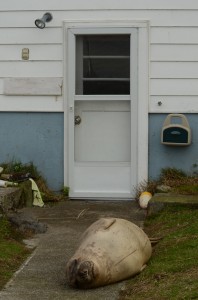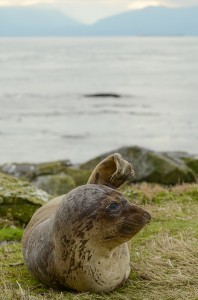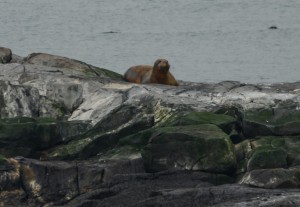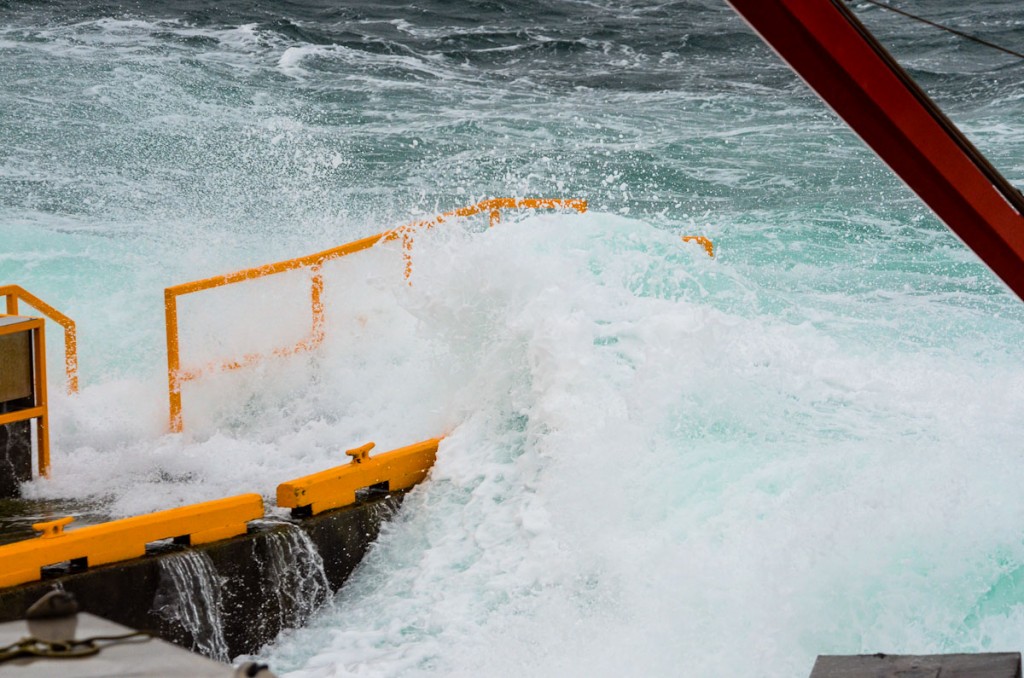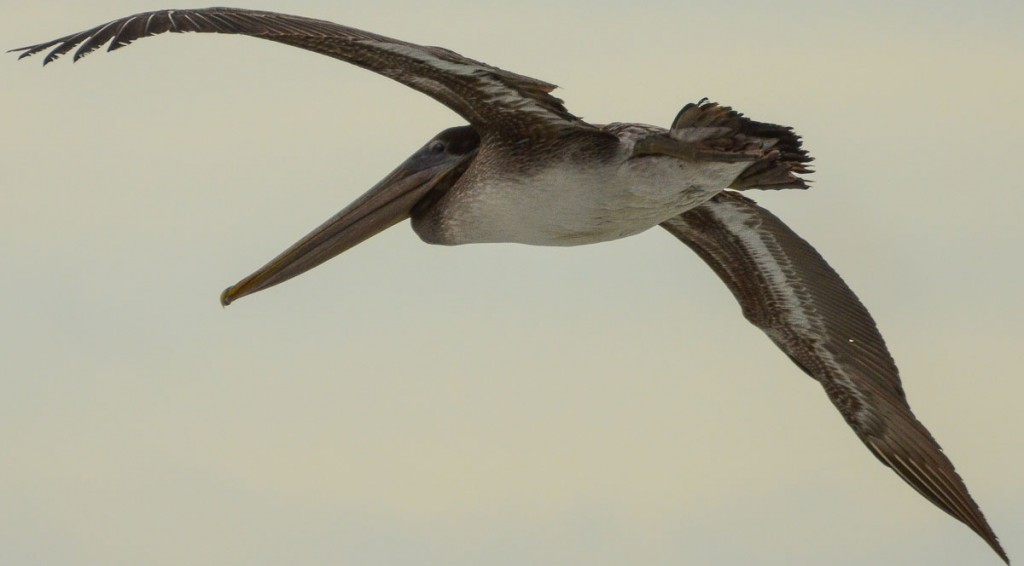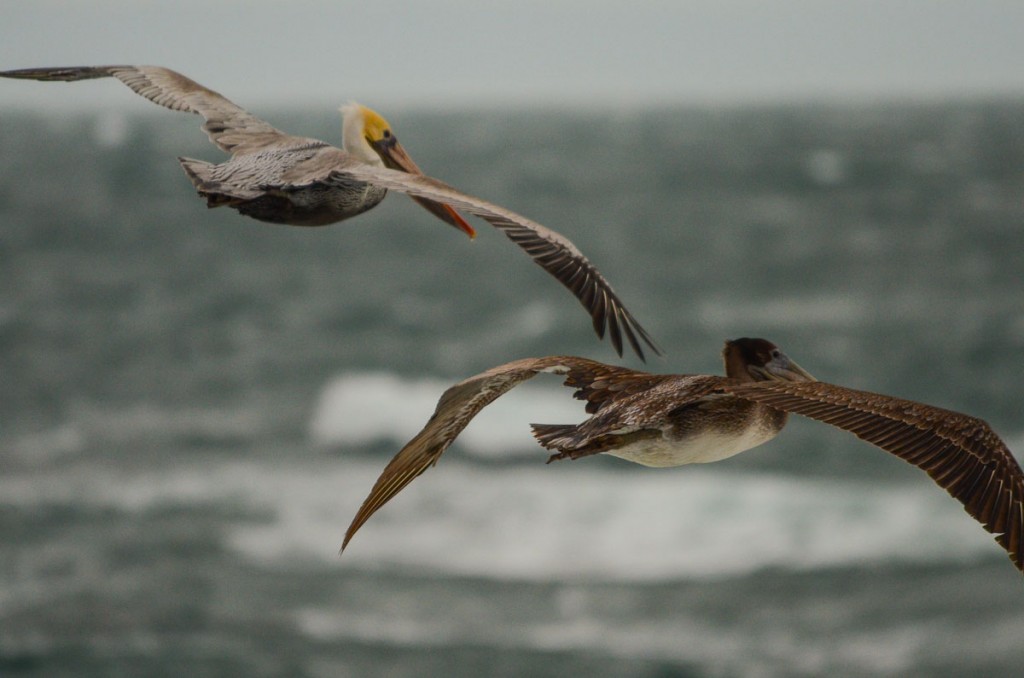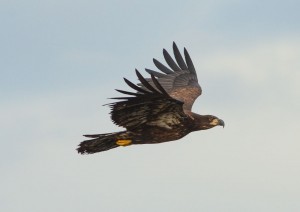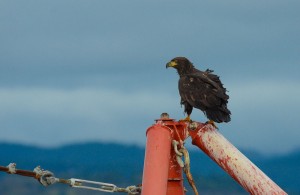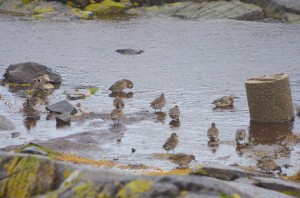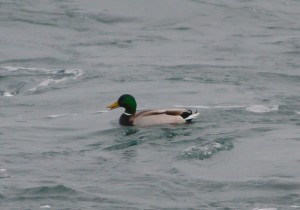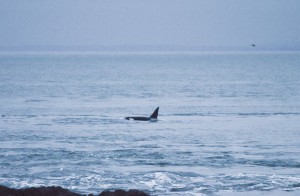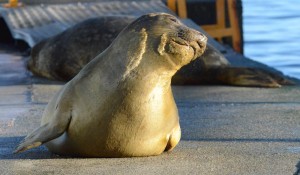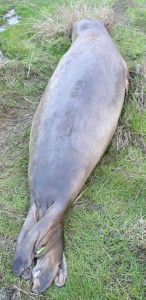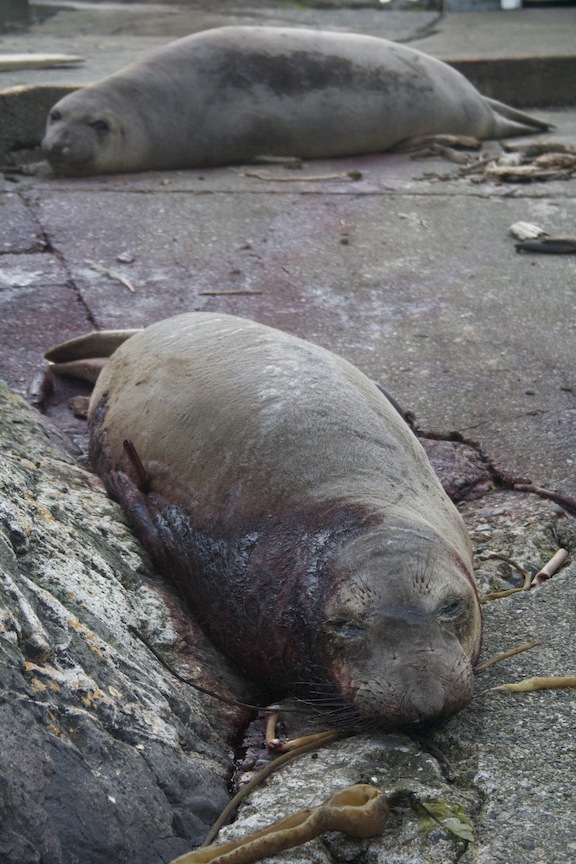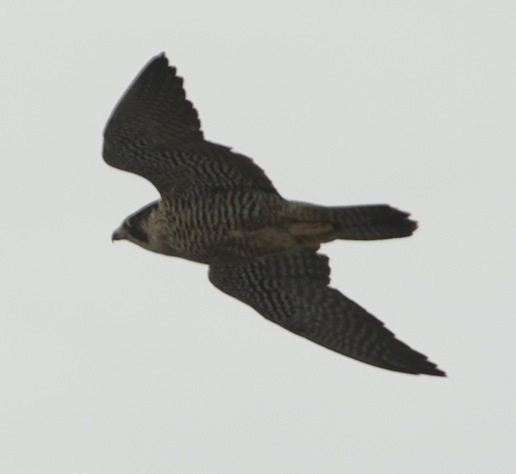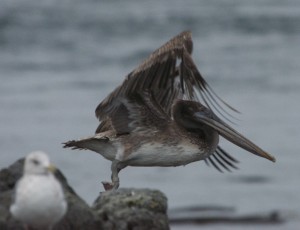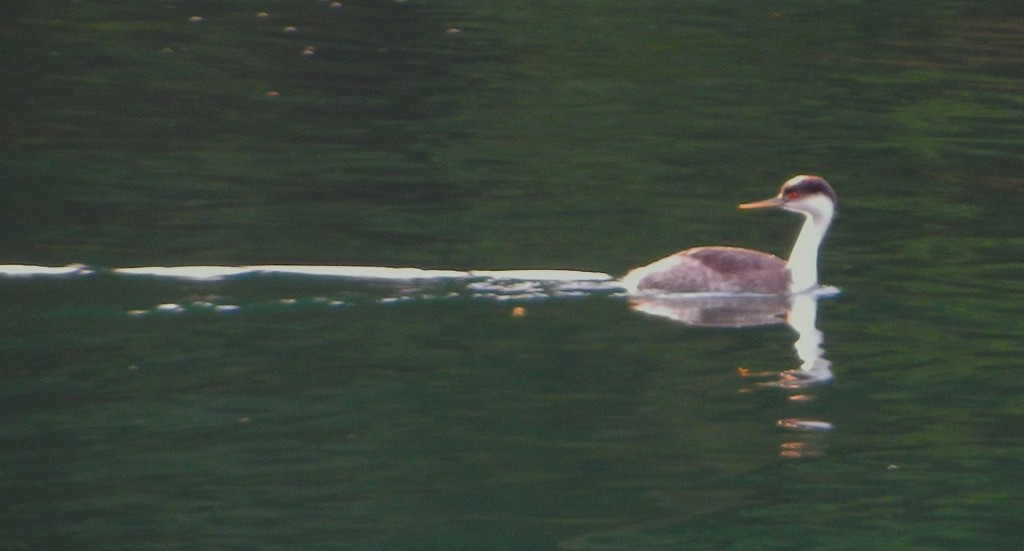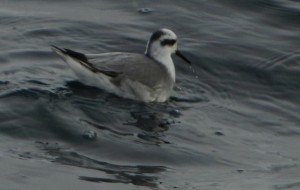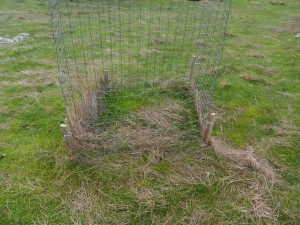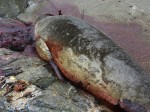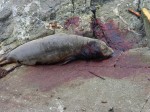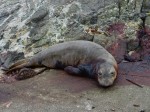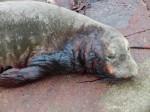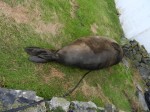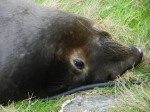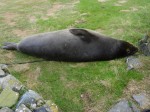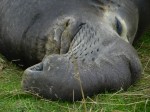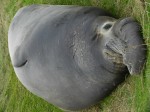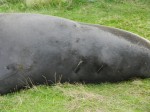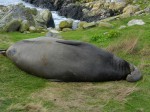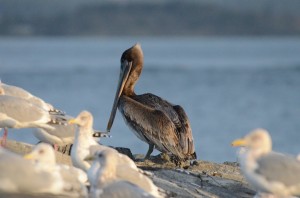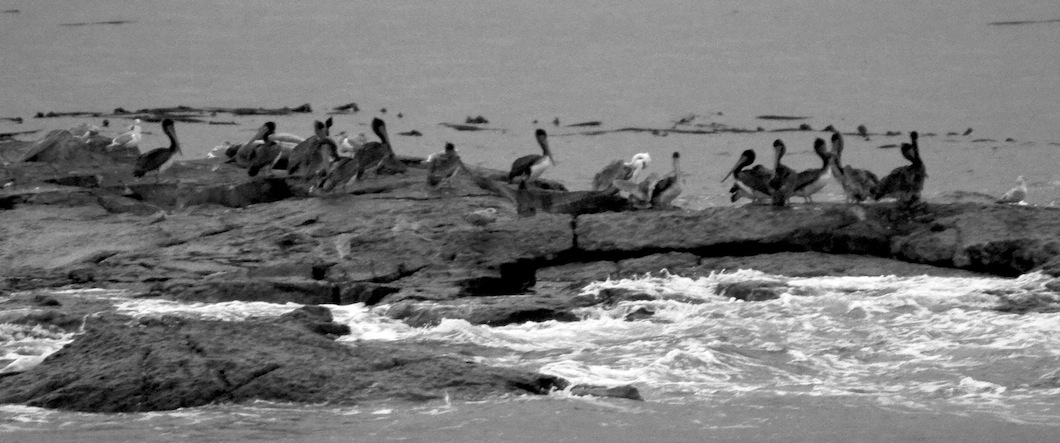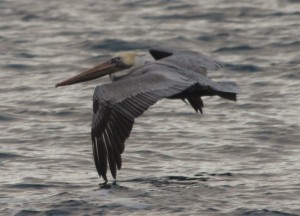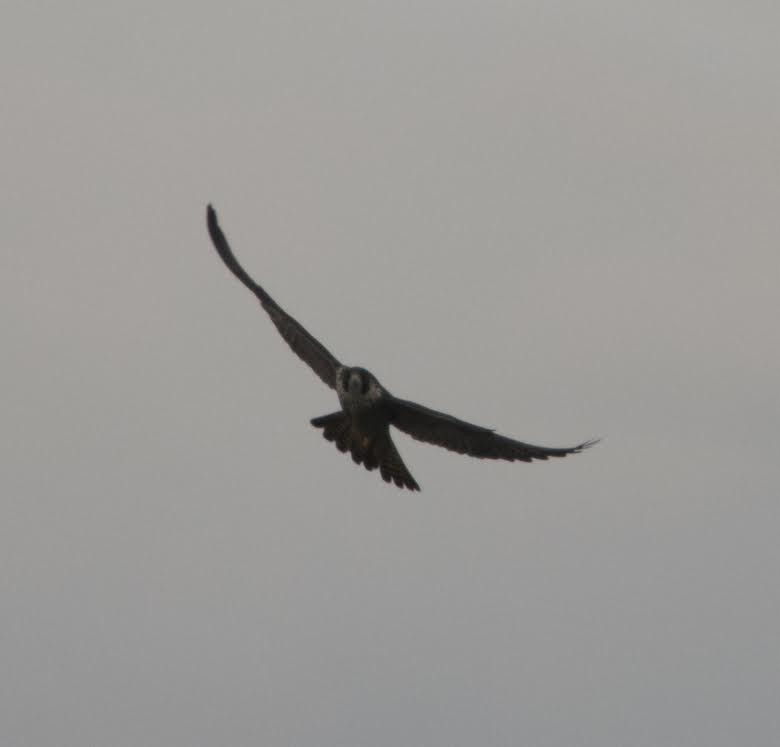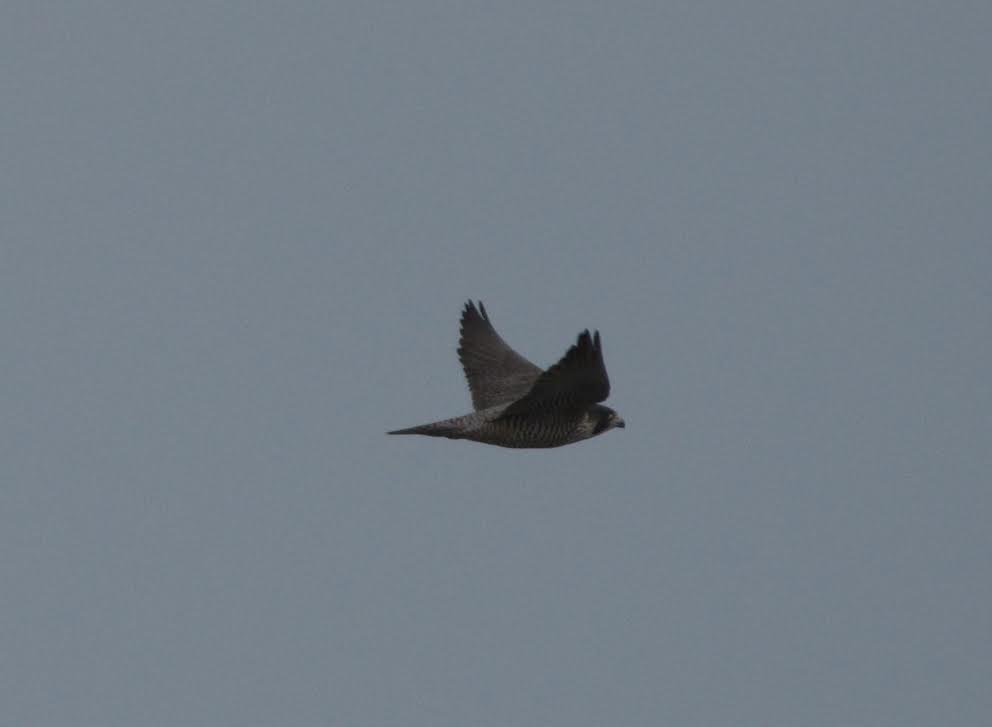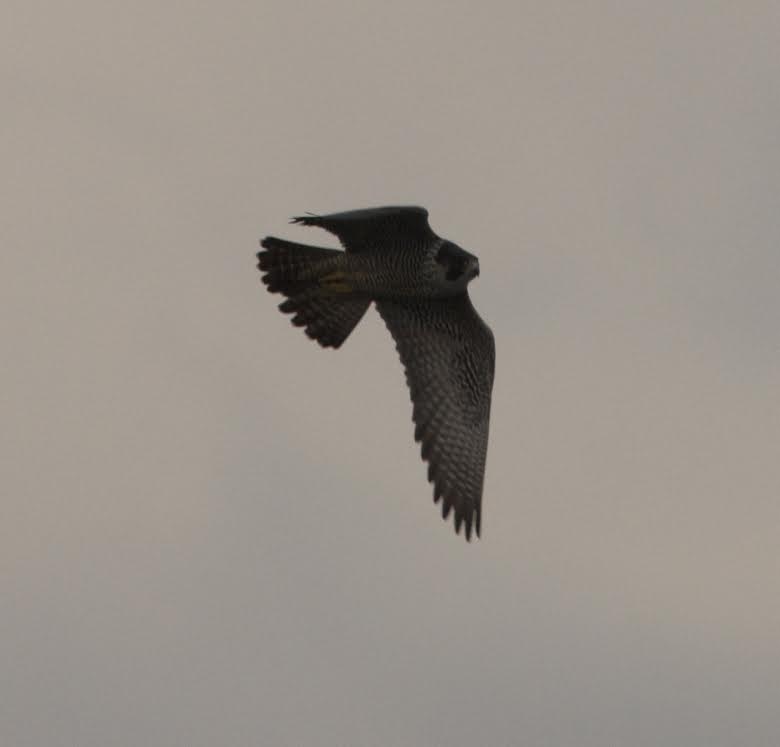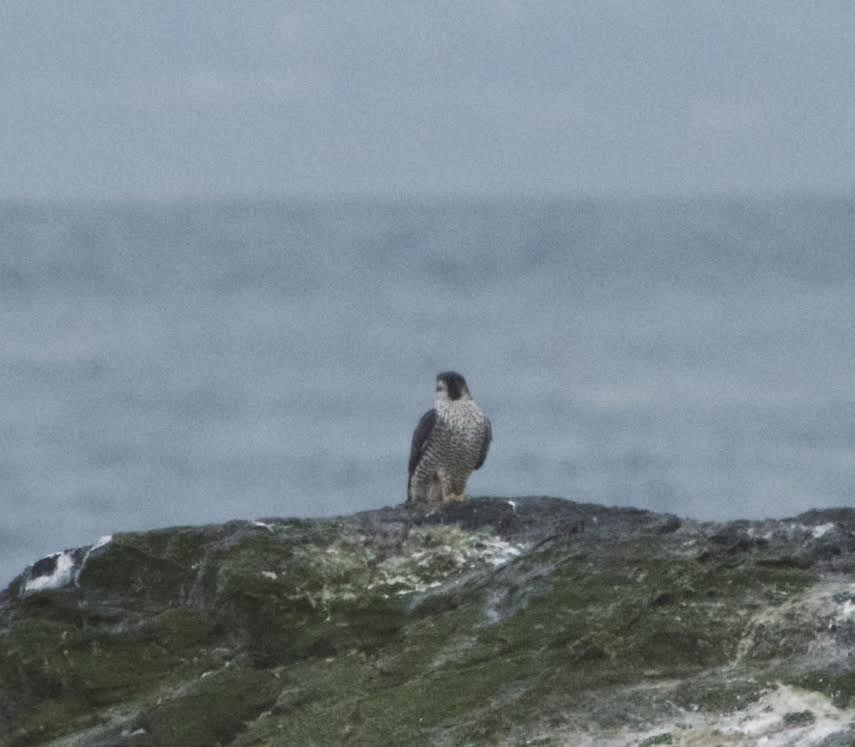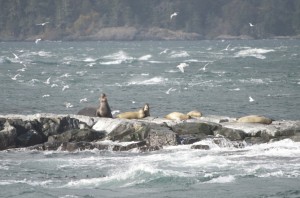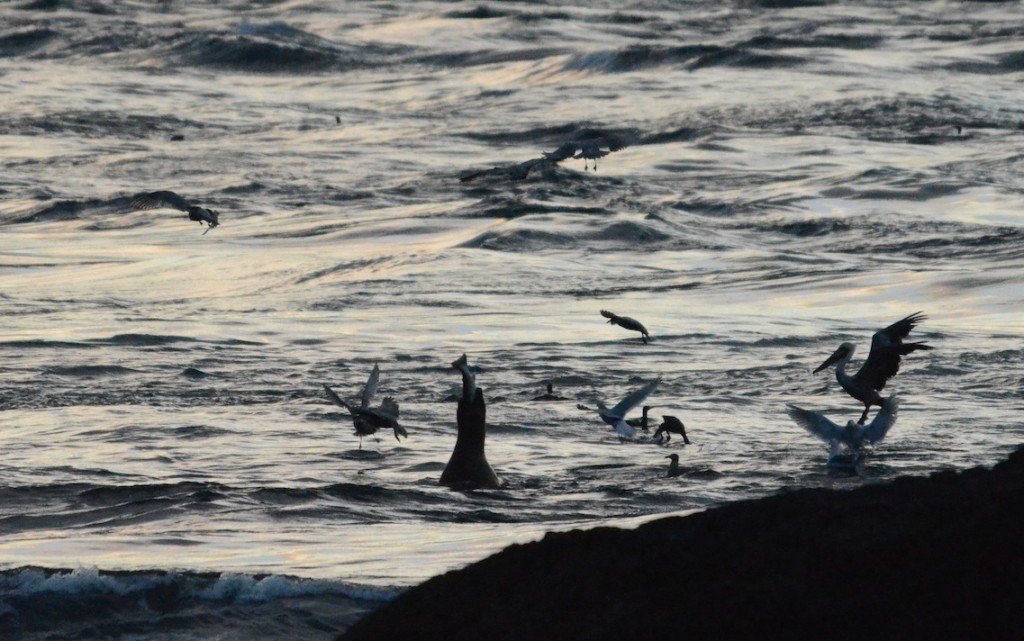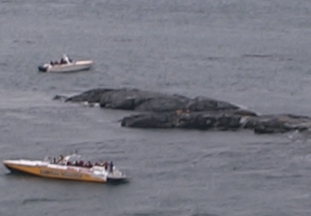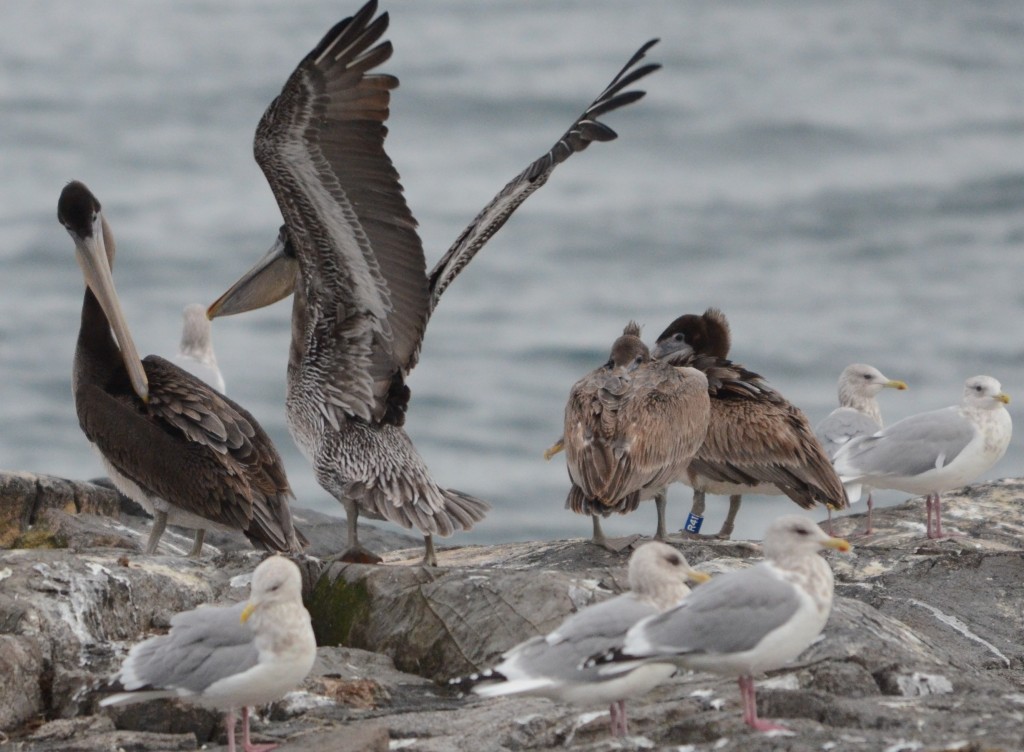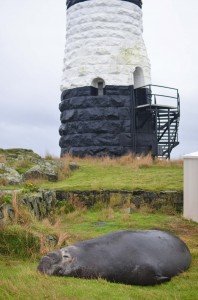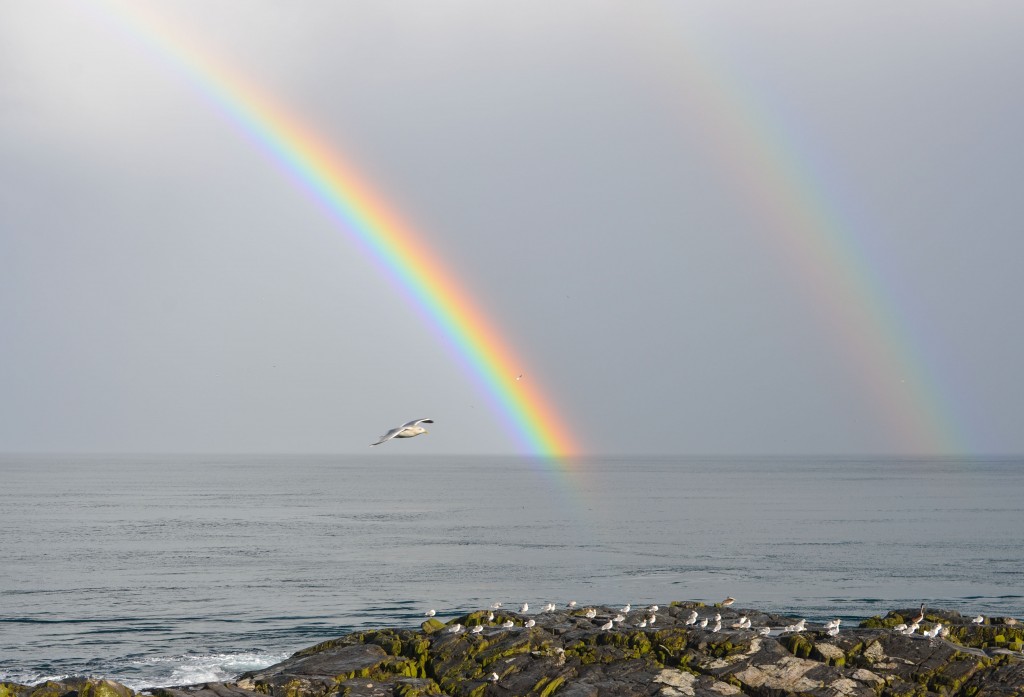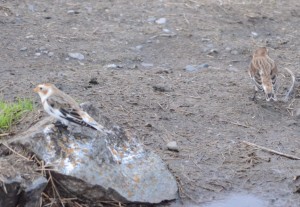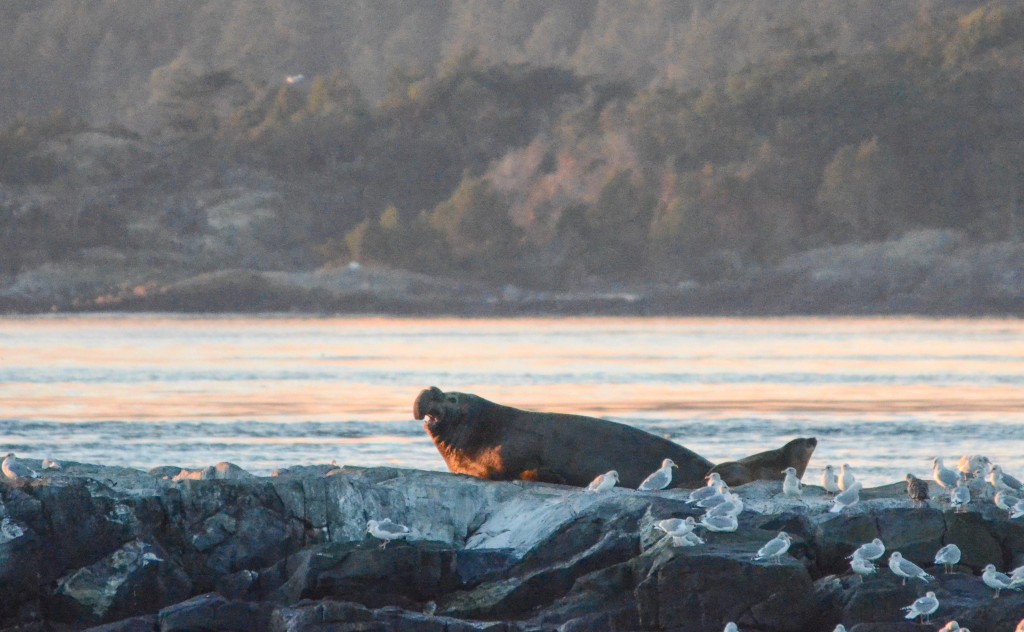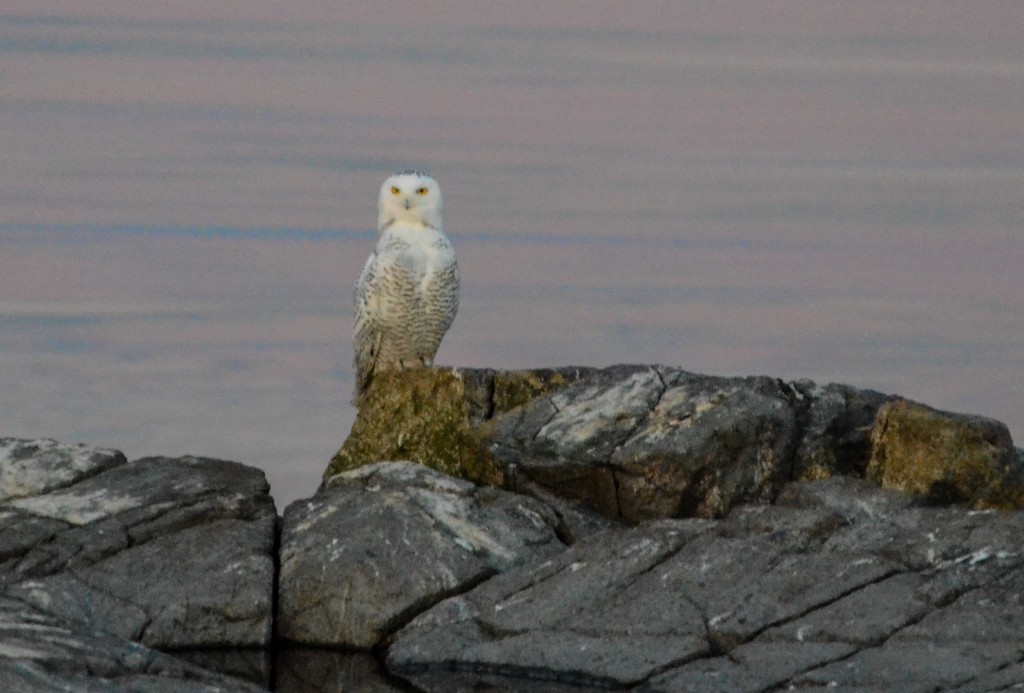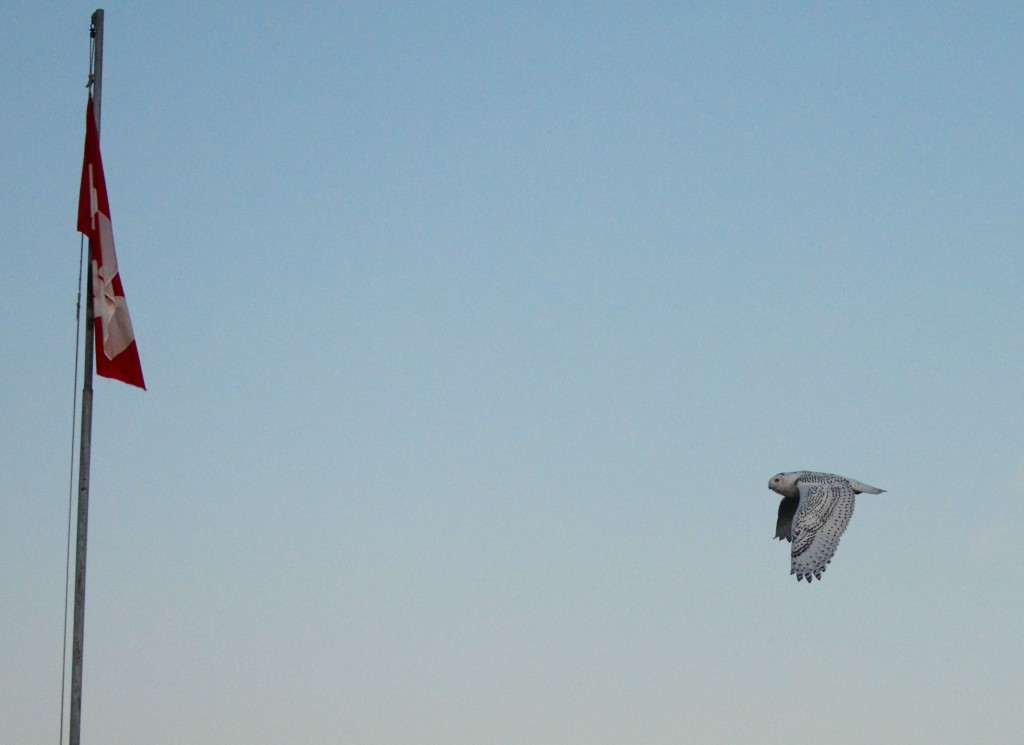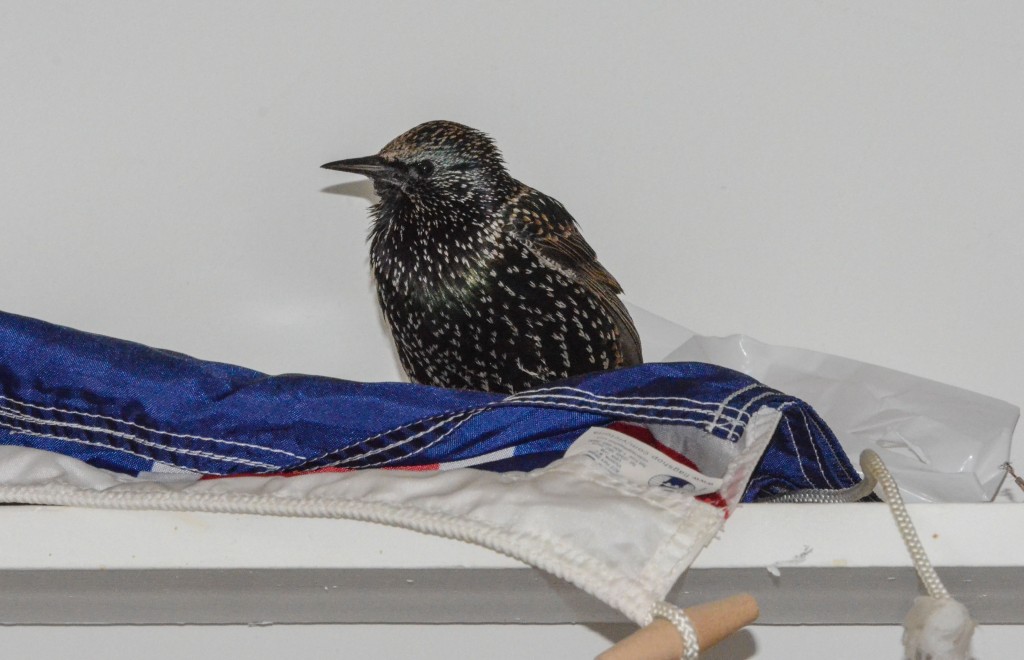The elephant seal population has been steadily declining over the past few weeks. For the last few days since Jan 19 there have not been any female elephant seals visible in the reserve. This is the time when elephant seal pups have been born out here in the past so it is somewhat surprising and a bit disappointing. Both male elephant seals have been back and forth between the main island and West rock and have been chasing and trying to mount the few small females that have been around, which is likely why they have all left.
Tag Archives: elephant seal
Weather past week
On Dec 25th Easterly winds were gusting over 40 knots pushing swells into and over the jetty. Zeke is seen below just above the jetty near the crane pad. The Pelicans pictured below were hovering in winds around 30 knots.
Since Dec 25th atmospheric pressure has climbed steadily reaching a high point of 1030 hPa yesterday, Jan 1. For the past several days we have had sustained NE winds between 10 and 20 knots which demonstrates the potential for harnessing wind energy at Race Rocks, particularly in the winter months when there is less solar radiation to charge the batteries. Pearson College is in the process of sourcing a wind generator for the island with the goal of further reducing and eventually eliminating dependance on fossil fuel electric generation in the Ecological Reserve.
Dec 24th
Have had some really nice weather out here since the storm. Pelicans are still stopping in and flying through the reserve, mostly in pairs or singles. Bald Eagles have been quite active in the mornings hunting.
On top of the crane, the eagle had just finished eating what looked like some part of a seagull. In this picture the eagle’s nictitating membrane is covering the eye. According to Baldeagleinfo.com, “every three or four seconds, the nictitating membrane slides across the eye from front to back, wiping dirt and dust from the cornea. Because the membrane is translucent, the eagle can see even while it is over the eye.”
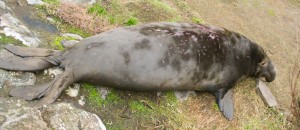 A few nights ago Zeke got some fresh wounds on his back from Misery, it was not as bad as the the last time. Him and Misery have been on the main island for several days now. I have not been seeing as many female elephant seals since the storm.
A few nights ago Zeke got some fresh wounds on his back from Misery, it was not as bad as the the last time. Him and Misery have been on the main island for several days now. I have not been seeing as many female elephant seals since the storm.
On Dec 19 there were 15 Green Winged Teals in a pool on the NE side of the island. This is the first recorded sighting of this bird in the reserve.
There has also been a Mallard duck in the reserve for over a week. Pam Birley first sighted it around Dec 18th, it was also the first recorded sighting of this bird in the reserve.
Yesterday after sunset a lone adult orca passed through the reserve going over Rosedale Reef.
Elephant Seals
There have been two tagged elephant seals on the main island over the past days, green tags 6397 and 6375. Misery has been on the main island, younger male on west rock. There continue to be a total of around 15 elephant seals in the reserve.
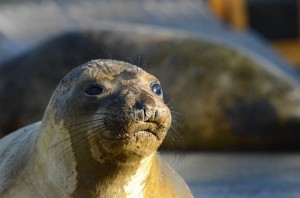 The yearling in the two photos on the left looks like she could be the one that was born here in January (named Squall) but it is hard to tell for sure.
The yearling in the two photos on the left looks like she could be the one that was born here in January (named Squall) but it is hard to tell for sure.
15 Elephant Seals
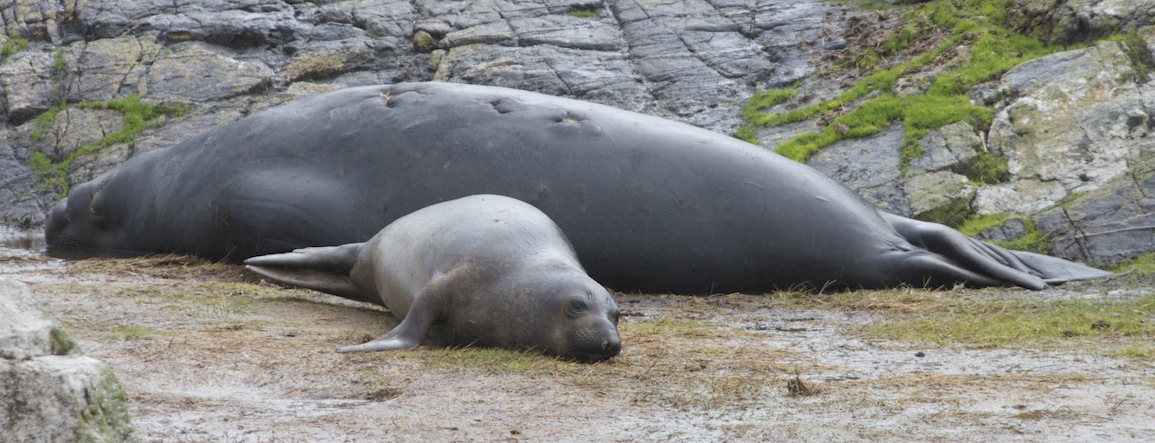
Male elephant seal younger than Misery with deep scars and a female elephant seal on main island Dec 8
On Dec 8 I counted 15 elephant seals in the reserve: 3 female and 2 male elephant seals hauled out on Great Race as well as 10 female elephant seals on West Rock. I think this is the most i have ever counter here.
Unfortunately one of the females on Great Race is injured in her mouth or throat and has been bleeding quite a lot. We have notified the Department of Fisheries and Oceans about her. There was an elephant seal in the spring that had a mouth injury as well.
The second male elephant seal is brave to venture onto great race while Misery, Alpha male, is about. This same elephant seal was here earlier this year, Mike posted about “chunk” at the end of May: https://www.racerocks.ca/2012/05/31/end-of-may/
And i think that it is the same one that had been around earlier that we were calling “Zeke”. I reported him injured here by Misery in February: https://www.racerocks.ca/2012/02/09/zeke-is-wounded/
The scars look similar, including a scar to his right eyelid. Misery does not seem to be very bothered by the other male being on the main island. The younger male has kept his distance though.
There has been a Peregrine hunting in the reserve the past three days, this picture taken Dec 8.
One tagged Pelican Dec 8 but not able to make out the ID #.
ER #97 Wardens Report, Dec.8 2012
Leaving the Docks at Lester B. Pearson College I noticed an unusually high number of western grebes. These birds (a species at risk) have an unusual migration pattern, in that they nest in wetlands on the Canadian prairies and then instead of migrating south as most other birds, they fly west, over the Rocky Mountains to winter in the small bays of southern Vancouver Island. We have few records of them at Race Rocks , but one that ended up at the docks dead made it into our taxonomy and gallery of species.
On the approach to Race Rocks one of those ever-changing sky scenes unfolded. We could see that the middle islands to the west are covered with Northern (Steller) sea lions today as well as a number of elephant seals . We only had time to check out Great Race Island as Erik was doing some underwater work, changing zincs on equipment and cleaning the underwater camera.
We could see that the middle islands to the west are covered with Northern (Steller) sea lions today as well as a number of elephant seals . We only had time to check out Great Race Island as Erik was doing some underwater work, changing zincs on equipment and cleaning the underwater camera.
As I tended him diving, a red phalarope (Phalaropus fulicarius ) swam in the waves near the dock, churning up plankton in a vortex . This is the usual location where we have sighting of the red-necked variety of these birds in the winter.
A year ago Alex set out three 1 square metre enclosures to monitor the effects of grazing and marine mammal trampling on vegetation at Race Rocks. In this one by the centre path it was evident that there is beginning to be a build up of organic material which will contribute to the turf cover.
Below are some of the pictures of the elephant seals on Great Race Island when we were there today. One female by the docks is injured as has been reported previously. Normally when there are natural injuries to animals out here we have a policy of not intervening as nature takes its course . When there may be evidence of a human cause for the injury where it may be treated, then the Department of Fisheries and Oceans has jurisdiction and must decide what to do. In this case, i suspect there is some irritation in the mouth or jaw which is causing continual bleeding, probably a fishhook. In the past we have had one successful treatment of an elephant seal when DFO arranged for the Vancouver aquarium to capture it and rehabilitate it. It was returned to the reserve at the end of summer in perfect health. So we have to wait and see what the decision is on this animal.
- Left side of injured female
- injured female see text above.
- Injured female
- injured female sea lion
- Ventral view of younger male
- The head of the younger male
- back view of the younger male
- Misery’s proboscis
- Tons of Misery
- Old back scars on Misery
- Mike Slater called him “Misery” several years ago because this animal was more agressive than others.
- Healthy female, probably 2 year old.
Again this year there are two males on the main island which could lead to some sparring around breeding time in January. The size of the proboscis on the younger male indicates his lesser age, and he is probably several hundred kilos lighter. It is quite amazing to see the amount of weight that Misery has put on over the past year.
Garry Fletcher
December 8, 2012
Ecological Reserve Warden for Race Rocks Ecological Reserve #97
Pelicans and a Peregine
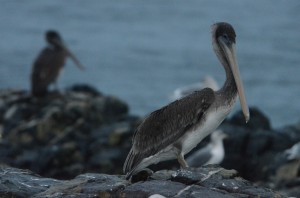 Since the last post there have been several visits of Pelicans to the reserve. My first sighting of 3 of them was on Saturday afternoon just before dark.
Since the last post there have been several visits of Pelicans to the reserve. My first sighting of 3 of them was on Saturday afternoon just before dark.
On Sunday evening a flock of around 20 pelicans landed on the West rock, joining the elephant seals that were there. The light was really poor so I couldn’t get a very good quality image. There has recently been a sighting of a similar size group close to Victoria, likely the same ones.
On Dec 3 there were 4 Pelicans sighted in the reserve as well as a Peregrine Falcon.
Misery has been on the main island up near the South side of the tower for several days. I have seen up to 8 other elephant seals on West Rock including a male that looks nearly as big as Misery.
On Tuesday morning and again in the evening the wind picked up to 40 knots from the West.
Change of Guardian
Wednesday morning we switched guardians, Mike has finished a 3 month shift and I will be here for the next 4 months. It has been 8 months since i was last out here, nice to see that Mike and Julie have done a great job out here and that the place is in good shape.
I have been on the lookout for the pelicans that Mike has observed out here and was thinking they were gone. But this morning, while photographing a sealion taking down a fish I noticed a large bird in the frame. The pelican must have been on the east face of the Eastern rocks which is out of sight from the main island.
On Wednesday the winds picked up to over 25 knots. Misery hauled out on the main island that night and stayed here until yesterday. After making his way down the ramp and through the debris he stayed at least an hour amongst the logs, floating and making bubbles.
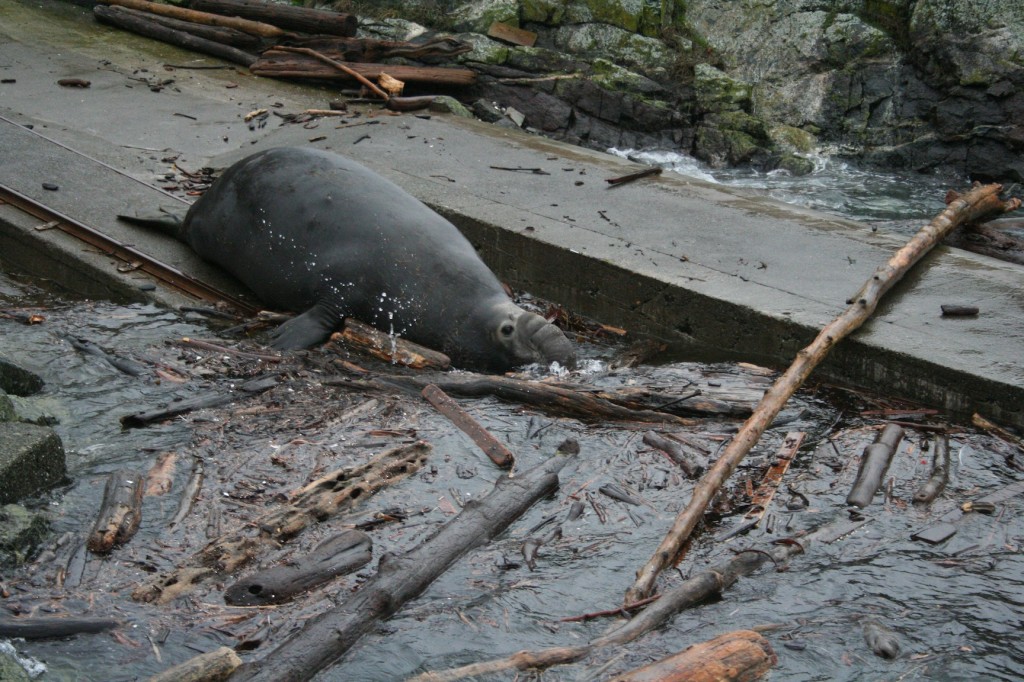
This morning Misery was out on West rock with at least 3 female elephant seals.
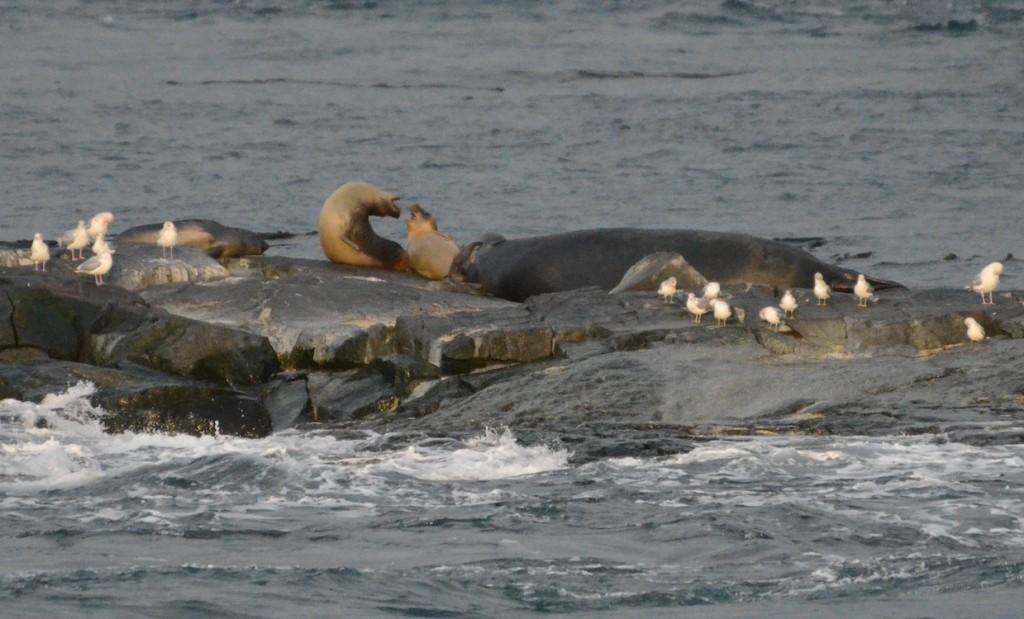
Not a lot of traffic in the reserve the past days. On Wednesday two whale watching boats toured around the elephant seals on West rock and today there is a dive boat off the west side.
Last days of November, and my shift…
Well my 3 month shift is almost over and plans are being made for Alex’s arrival for the winter. The station is looking pretty good and all systems are working well. The time of the Sea Lion fades and the time of the Elephant Seal begins…
A few pelicans remain including this second banded individual, R41. You can learn more about pelican conservation at: http://blog.bird-rescue.org/ (and many other birds…)
King Misery is quietly staking his territory, going back and forth between here and Middle Rocks. The young male Chunk is about, and being cautious, but Misery hasn’t pummelled him yet as far as I can tell… there are about 8 E-seals in the Reserve.
We have had beautiful and oft-changing weather over this last week. I caught this double-rainbow the other day… Note pelicans on rocks beneath…
And finally these sparrow-sized birds were about for a few days, feeding voraciously. These are snow buntings, down from their summer range in the Arctic.
Pelicans and Owls and Misery!
It is mid-November isn’t it? So why did 9 pelicans just fly by the window? And yesterday a Snowy Owl showed up for the night. Is there something going on with the weather or climate that is encouraging this? We live in interesting times… and speaking of interesting, Misery returned the day before yesterday. I noticed him down at the boat-ramp and we had a little chat! I felt he recognized me! Later he lumbered up onto the lawn looking very fat and sleek, well-prepared for his 2-3 month fast ahead while he stakes his territory, fights off potential challengers, and “courts” any females that might around.
Lastly the other day I heard a commotion in the kitchen and upon investigation I discovered a bird in the oven vent. I removed the cowling and this European Starling appeared and flew around the house for a while. Starlings are a species introduced from Europe (Sturnus vulgaris)in 1890. About 60 were released into New York’s Central Park in an effort to introduce every bird species mentioned in the works of William Shakespeare. By 1945 they were appearing in the Pacific Northwest. About 200 million are thought to exist in North America presently.

